Stretch Marks
Stretch marks are common during pregnancy. Although they are not harmful, they are unsightly.
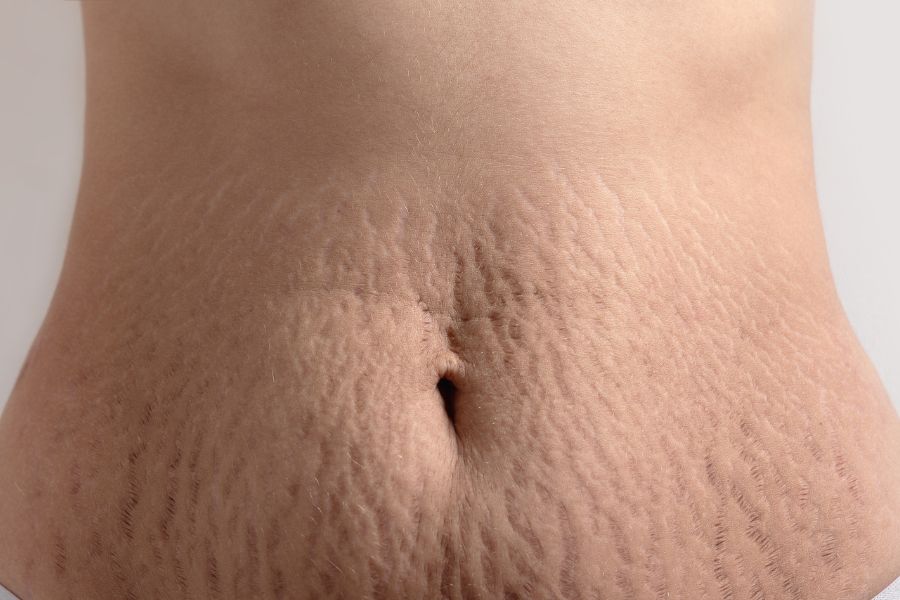
What are Stretch Marks?
Stretch marks occur when skin is stretched, often during pregnancy. They can be identified through pink or purplish streaks on the skin. These streaks will eventually fade into pale or white lines after childbirth. Stretch marks commonly appear on the stomach, but can also be found on the hips, thighs, buttocks, and breasts. Removing stretch marks is challenging and may come with other skin issues like skin laxity and fat accumulation in the abdomen.
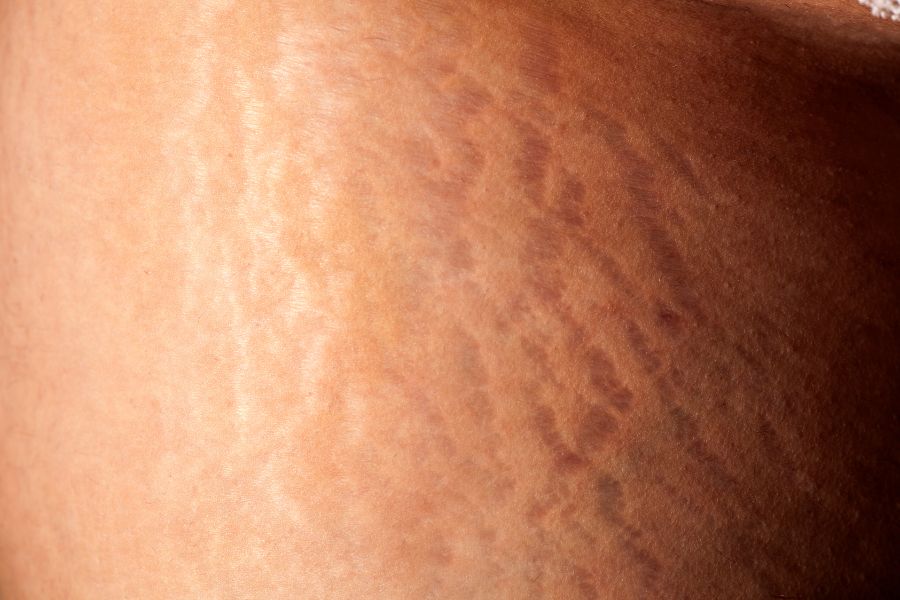
Causes
Stretch marks during pregnancy are caused by hormonal changes and skin tears when the belly grows quickly. Not everyone gets them – factors like genetics, weight gain, and carrying multiples also play a role.
1. Glucocorticoids
During pregnancy, the body produces many glucocorticoids that weaken skin fibers. When the baby grows fast, the fibers can’t stretch enough and tear, causing stretch marks.
2. The baby in your womb
Stretch marks can happen when the baby is big or overdue. As the baby grows, the belly gets bigger too. If the skin can’t stretch enough, it can tear and cause stretch marks.
3. Rapid weight gain
Putting on weight quickly during pregnancy increases the likelihood of getting stretch marks. If your skin stretches too fast, it is more likely to leave a mark.
4. Lifestyle
Your lifestyle prior to pregnancy can increase the chance of stretch marks. A sedentary lifestyle or lack of skincare can result in weaker muscles at the waist and abdomen as well as less skin elasticity.
5. Genetics
If your mom has stretch marks, you may be prone to them.
Symptoms
Stretch marks start off as pink or purplish lines that are rippled and streaky. They can be itchy or sore. After giving birth, they will become white or silver scab-like lines. Stretch marks are mainly found on the abdomen but can also appear on the thighs, buttocks, etc. They are more noticeable during the first pregnancy.
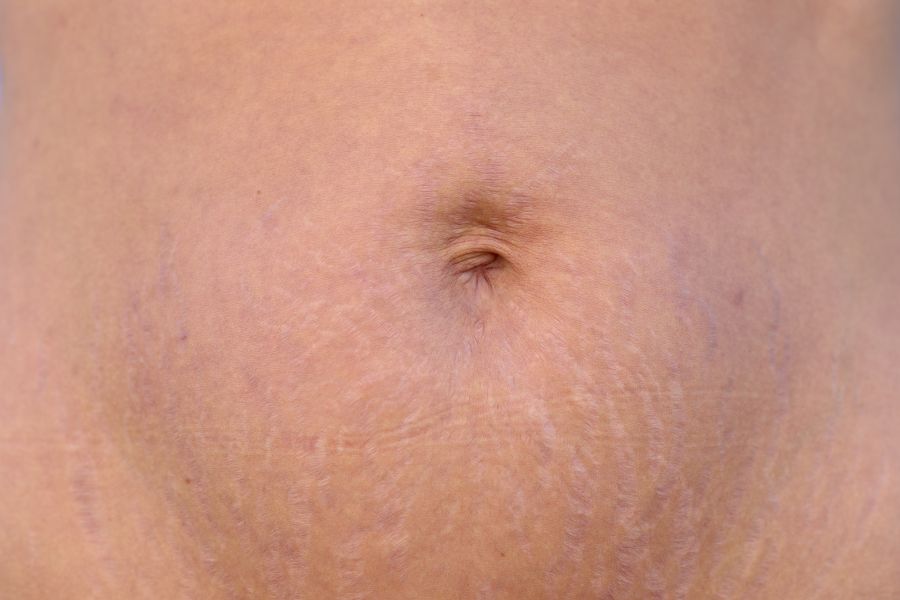

Treatment
In Skinspire Laser&Skin Clinic, you can simply lose fat at specific body parts by the Lipodissolve Injection.
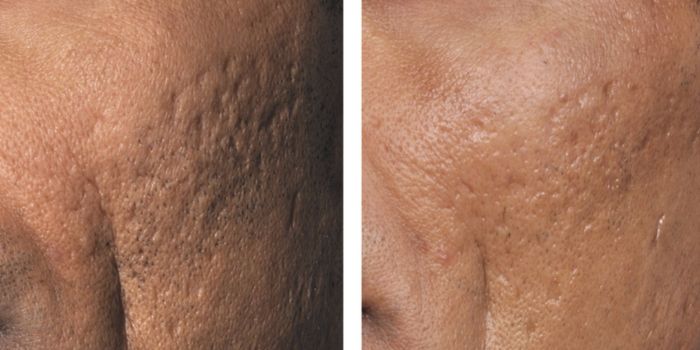
PicoSure offered by Skinspire Laser&Skin Clinic, is an FDA-approved laser that removes tattoos and pigmentation safely and effectively. It uses a specific wavelength of light to remove melanin without causing as much damage as traditional laser treatments. This specific lens stimulates collagen and elastic fibers, improving the elasticity of aging cells.
How does PicoSure Laser work
In “BOOST” mode, the PicoSure can increase pressure by 70% by adjusting pulse width from 750 to 550PS. Melanin-absorbing 755 nm wavelength light is emitted, releasing all energy in picoseconds. The high energy causes melanin to burst into smaller particles which the body eliminates.
Procedure
- 1. Skin Test: Skinspire Laser&Skin Clinic provider will provide a skin test to access skin condition or existing skin problems.
- 2. Face-to-face consultation: Skinspire Laser&Skin Clinic provider will provide treatment plan based on client’s needs and goals.
- 3. Pre-treatment preparation: Skinspire Laser&Skin Clinic provider will clean, disinfect, and apply anesthetics at the treatment areas, and put on safety goggles.
- 4. During the treatment: Skinspire Laser&Skin Clinic provider will deliver wavelength pulse at the targeted areas using PicoSure, repeat steps at the severe pigmented areas.
- 5. Post-treatment: Skinspire Laser&Skin Clinic provider will apply aloe vera gel to soothe and calm down the treatment areas.
- 6. Post-treatment caring.
Who is it for
- People who want to get rid of stretch marks
- People who want to improve their scars, large pores and skin texture
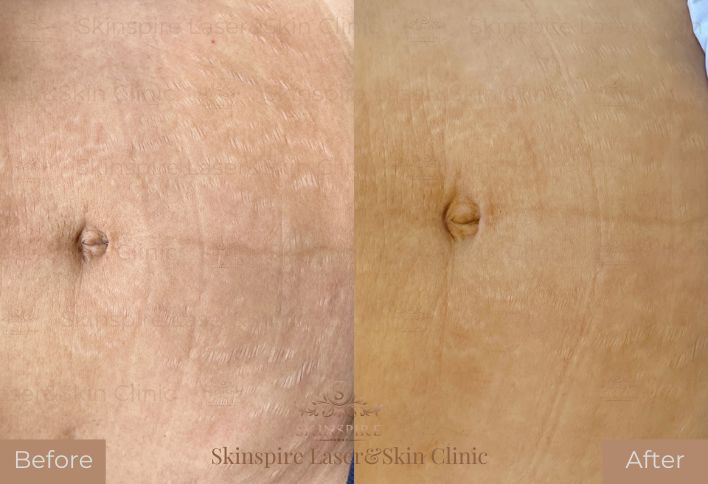
RF Microneedling offered by Skinspire Laser & Skin Clinic, combines matrix application, microneedling, and radio frequency technology. A device with fine needles creates tiny punctures in the skin, stimulating the production of collagen and elastin. Results may include improved skin texture and firmness, as well as resurfacing.
How does Radiofrequency (RF) Microneedling Laser work
A sterile tip with gold-plated microneedles is used to stimulate the skin’s natural healing process. Microneedles are inserted into the skin and energy is transmitted to heat collagen fibers, damaging sebaceous glands to reduce pore size, acne development, and control oil secretion.
Procedure
- 1. Skin Test: Skinspire Laser&Skin Clinic provider will provide a skin test to access skin condition or existing skin problems.
- 2. Face-to-face consultation: Skinspire Laser&Skin Clinic provider will develop unique treatment plan based on client’s condition and desired results.
- 3. Apply anesthetic: Skinspire Laser&Skin Clinic provider will apply anesthetic externally. Clean and disinfect the treatment areas.
- 4. Pre-treatment preparation: Skinspire Laser&Skin Clinic provider will draw markings on the face to define treatment areas, confirm the package of the new tip of the applicator has not been opened.
- 5. During the treatment: Skinspire Laser&Skin Clinic provider will perform the treatment as planned, precisely adjust the RF energy output and depth.
- 6. Post-treatment repair: Medical-grade facial repair mask + QDEL phototherapy mask to nourish and repair the skin.
- 7. Post-treatment care.
Who is it for
- People who want to get rid of stretch marks
- People who want to improve their scars, large pores and skin texture
- People who want to tighten their skin and reduce the appearance of wrinkles
- People who want to get rid of their skin roughness and create a smooth and bright skin on their body

Microneedling with PRP (Platelet-rich plasma), offered at Skinspire Laser & Skin Clinic, is a cosmetic treatment that stimulates collagen production by rolling fine needles over the skin and applying platelets, which are one of the components of blood. PRP contains proteins, including growth factors and cytokines. These proteins help skin tissue repair itself.
How does PRP work
After a small blood draw, your clinician will apply a topical anesthetic to your face. Then they’ll pass over it with a microneedling pen or derma-roller. These devices prick tiny holes in your skin, stimulating its natural healing processes – and creating channels for the PRP. In addition, the tiny breaks in the skin stimulate collagen production in the deeper layers of the skin which allows for facial rejuvenation by reducing the appearance of wrinkles and scars.
Procedure
- 1. Skin Test: Skinspire Laser&Skin Clinic provider will provide a skin test to access skin condition or existing skin problems.
- 2. Face-to-face consultation: Tailored a suitable PRP treatment plan based on client’s conditions and desired results.
- 3. Pre-treatment preparation: Draw blood from the client and obtain concentrated platelet solution by centrifugation; apply anesthetics, clean and disinfect the whole face.
- 4. Treatment: A microneedling device is then rolled over the area to be treated, and the PRP is applied to the skin.
- 5. Post-treatment care: Medical-grade facial repair mask and QDEL phototherapy mask to nourish and repair the skin.
- 6. Post-treatment precautions.
Who is it for
- People who want to get rid of stretch marks
- People who want to improve their scars, large pores and skin texture
- People who want to get rid of their skin roughness and create a smooth and bright skin on their body
